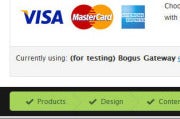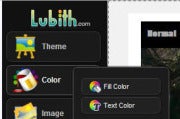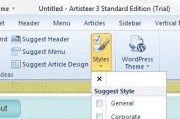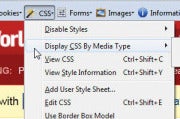Build Personal Websites
If you're just starting out creating content online, you may want to limit yourself to designing a personal page or website. One of the best ways to do this is to use a service called Flavors.me. The tools in Flavors.me let you assemble a personal webpage sporting a large, visually striking photographic background, and they can pull in feeds of your activity across the Web. For example, you could present material from Facebook, from your Flickr page, from Foursquare, and from numerous other online services. Flavors.me has a free version, but reserves some of its more powerful features for the $20-per-year paid version, such as the option to serve your page on your own personal domain.
Open an Online Store or a Business Site


Maybe you need to create a business website, instead, so that you can offer products or services in an online store. Shopify(starting at $29 plus transaction fees per month, 30-day free trial) is one hosted service that can help. Setting up a store with Shopify is easy, and the company does much of the heavy lifting--such as credit card processing--for you.
If the website you wish to open is not exactly a personal home page but isn't an online store either, consider a more general-purpose service. Weebly is a service that lets you create pretty much any kind of website you can think of, using visual drag-and-drop tools.
Start Your Own Blog
Blogs are another important category of websites. And by far, the most popular blogging platform in the world is WordPress. On WordPress.com you can open your own blog and customize it free of charge. The service currently hosts about 30 million different blogs, so it must be doing something right.


Once you have established a WordPress.com site, you may want to get into more sophisticated options. At this stage, it's a good time to think about paying a professional Web hosting company to host your site. One great host is DreamHost, which offers plans starting at $9 per month with excellent technical support and easy installation of various content management systems, WordPress very much included.


A WordPress-based site can be extremely versatile. It doesn't necessarily have to be a blog: Many sites use WordPress as a complete content management system, and you can customize and extend WordPress via numerous different plug-ins and themes, both free and commercial. A good place to start customizing your WordPress installation is in its theme, or look and feel. Online service Lubith lets you create your very own WordPress theme simply by dragging and dropping design elements. Once your theme is ready, you can download and apply it. Another interesting option is WP PaintBrush, a premium theme that lets you transform your blog in assorted ways.
If you'd rather design your WordPress theme in a Windows application, try Artisteer. A commercial tool priced at $130, Artisteer lets you create themes not just for WordPress but also for several other content management systems.
Take Things to the Next Level
While WordPress is a fantastic system, it is definitely not the only game in town. After you've built a WordPress site or two, you may want to expand your horizons and learn more about Web development in general. One good resource is Lynda.com. At this site you can view detailed online video courses on a wide variety of computer-related subjects. For instance, I've used Lynda.com to learn more about PHP programming, as well as about Ruby; the videos weren't always riveting, but they were certainly useful.
If you like the idea of writing your own code, you're going to need a good programmer's text editor. I personally recommend Vim. It's an ancient editor that is still under active development, and it can be tricky to master. Once you get the hang of it, though, you may well wonder how you ever wrote code without it.


As you begin to play around with general-purpose Web development, remember that no matter how much theory you acquire, practice makes perfect. For example, CSS, or Cascading Style Sheets, is an important Web technology for defining what a site looks like. Once you know a bit about CSS, you can practice it through online service WebPutty, which lets you write CSS (and SCSS, an advanced CSS syntax) and see the changes apply instantly to your website. You might also use Firefox extensions such as Firebug and the Web Developer toolbar, which can help you debug JavaScript and quickly prototype CSS.
Whether you're just starting out with Web development or you already know CSS 3 by heart, pick the tool or tools appropriate for your skill set. The programs available are powerful enough to do all of the hard work, whether you're building a new site (be it your first or your tenth) or buffing an existing one to an irresistible shine.
0 comments:
Post a Comment